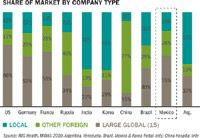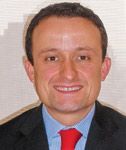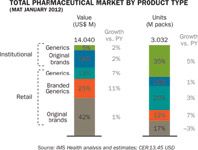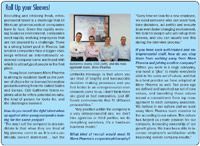Country Report: Mexico
Over ten years ago, the economic concept of the 'BRIC' countries-Brazil, Russia, India and China-was formed, and it's pretty much all we've heard about ever since. Yet earlier this year, the very same man who coined the term-Jim O'Neill, chief economist at Goldman Sachs-declared that by 2020 Mexico would be the seventh largest economy in the world, surpassing both India and Russia. Mexico belongs to one of four recently defined 'growth markets' alongside Indonesia, South Korea and Turkey. That certainly shakes things up a little for both outside observers and active local stakeholders in the economy.
This sponsored supplement was produced by Focus Reports.
Project Director: Julie Avena
Research and Editorial: Kirsty Avril Jane Walker
Project Publisher: Béatrice Collet
Graphic Assistance: Christine Guiang
For exclusive interviews and more info, please log onto or write to contact@focusreports.net

Photo credit: Kirsty Avril Jane Walker
But what does this recent categorization as a 'growth market' suggest for Mexico's pharma industry, recently left red-faced in regional second place after Brazil's bullish and apparently unstoppable growth?
With an estimated value between 12 and 14 billion USD, the Mexican pharmaceutical industry has seen some significant changes over the last four years. The government has significantly increased public health spending and coverage in an effort to pull Mexico up from the bottom of the pile; according to the latest OECD Health Data, Mexico fared 33rd out of 34 OECD countries for total expenditure on public health as a percentage of GDP. The government is also fighting against rapidly increasing levels of chronic long-term illnesses rife in the population, such as diabetes.
Most notably, the Popular Insurance Scheme 'Seguro Popular' increased its coverage from 17 million Mexicans to more than 50 million who were previously not under any kind of health scheme. Now almost every single Mexican in the country is covered under a public health system.
The Federal Commission for the Protection against Sanitary Risk (COFEPRIS) oversaw several recent regulatory changes. Suppression of the manufacturing plant law in 2008 enables foreign pharmaceutical companies to distribute and sell their products in Mexico without the presence of a manufacturing plant on Mexican territory. The deadline for new generic drug registrations passed in February 2010 which, after being subjected to stringent bio-equivalency testing, cleaned up an estimated 7000 products from the market. Additionally, the antibiotics law was enacted in August 2011, requiring a prescription to be presented before any antibiotic can be dispensed.

Rafael Gual, General Director, CANIFARMA
For Rafael Gual, general director of CANIFARMA, the National Chamber of the pharmaceutical industry, there is one goal that COFEPRIS must still achieve, "Full recognition [from PAHO, the Pan American Health Organization], which will provide a strong opportunity for national companies to reach the Latin American market; a win-win situation for both industry and government."
These wide-reaching changes have affected industry dynamics, and coupled with the patent cliff and the worldwide innovation drought, have opened up a bigger space for generics penetration and created the perfect storm that has pushed present multinational companies to either diversify, or to focus on niche markets. Mexico's solid macroeconomic policies and encouragement of foreign investment have also increased competition in the market, pushing local companies to take a side step on their strategies and in some cases to be more resourceful and aggressive in retaining and increasing their share of the pharmaceutical pie.
Last but not least, there has been an undeniable shift of power towards the point of sale: pharmacies and supermarkets. Pharmacy giants are taking warehousing and distribution into their own hands and private label (store brand) drugs are becoming increasingly popular. Some say positioning a general medical service with doctors at the point of sale has created an even bigger demand for private label medicines at the expense of other brands. For many players in the market, it is a bitter pill to swallow.

Mexico certainly offers a lot of growth potential. One can debate whether Mexico is still truly an emerging market, but as Ricardo Alvarez Tostado, president and general director of AstraZeneca Mexico points out, "It is not how fast you grow, but how consistent your growth is over time, and I genuinely believe that Mexico is very well positioned through a rigorous monetary policy and an improving fiscal policy. It is a democratic, free enterprise emerging market. Mexico is, and will remain, a strategic market for any industrial interest."
But to grow, or in some cases survive, pharmaceutical companies must adapt to dynamic market conditions. Those who manage to achieve this flexibility in Mexico will be the ones with smiles on their faces in 2020 as successful players in one of the world's largest economies.
AN OUTSTANDING EXAMPLE
Healthcare has been a top priority in Mexico for the last ten years, with the government working hard to keep its promise of universal coverage and increased hospital and medical infrastructure throughout the country.
As a testimony to this, Margaret Chan, the director general of the World Health Organization, openly praised the Mexican government at the International Forum on Universal Health Coverage in Mexico City on April 2nd, 2012 by stating: "I am pleased to hear that Mexico is achieving its goal [of universal coverage], with health care available to everyone in the country. This gives the world an outstanding example of what can be achieved through high-level political commitment."

Ricardo Alvarez Tostado, President and General Director, AstraZeneca Mexico
Under the current system, there are three major institutions. The Mexican Institute of Social Security (IMSS) is the largest social security institution in Latin America. IMSS covers all formal workers in the private sector, which according to the latest IMS Health data represents 44.3% of the total population.
The Institute of Health and Social Services (ISSSTE), covers all government workers and represents around 9.8% of the total population. Recent financial restructuring and cost saving initiatives within both IMSS and ISSSTE have contributed to a strongly pro-generics attitude within the two health systems.
Thirdly, Seguro Popular was created in 2003 as a type of public insurance scheme to provide health service coverage for Mexicans not affiliated with any social security institution. Seguro Popular has been the main driver of increased public health coverage, and the government recently pledged that 80% of state-purchased medicines should be comprised solely of generic drugs.
The Mexican pharma market has always had an historically low generics penetration, and these three initiatives are pushing it firmly towards a more generics-focused environment.

Although the pharmaceutical industry has expressed its delight at such a noble scheme, the government healthcare systems have not been without their problems. Many people in the industry feel that when price is the only basis on which to win a government tender, quality falls into second place.
Hector Carillo, general director of Apotex Mexico, points out that "The government continues to be a good business for us because supplying on time is becoming increasingly important. When it comes to timely and high quality product delivery, they know we can do it. But we cannot supply at their requested benchmark prices. They demand the lowest possible pricing from the market, and while we understand Seguro Popular has a limited budget and is required to look for the lowest possible prices, Apotex cannot compromise on quality just to get the extra sale."

Héctor Carrillo, General Director, Apotex Mexico
Alongside these pricing concerns are questions over the administrative complexities of Seguro Popular and the fact that it is run locally across each State in the country. This is causing headaches for pain specialists Grünenthal.
Tomas Bordonaba, general manager of Grünenthal de Mexico notes that, "The institutional market represents a big opportunity for Grünenthal, but it has additional complexity because every state manages its own budget and has its own priorities. You have to create an individual strategy for every state." He also goes on to say that, "In general, the awareness of the importance of correct pain management strategies is growing across the different institutions, and Grünenthal is playing a key role."

Tomas Bordonaba, General Manager, Grünenthal Mexico
Awareness within government institutions and the need to treat certain conditions has become a priority within the pharmaceutical industry. Since public health institutions have increased their coverage of the population, the sales ratio between the government and the private market for the pharmaceutical industry as a whole has shifted in favor of the government. Awareness is the key that unlocks the door to new business opportunities, otherwise known as market access. This has been surprisingly rosy in recent times as Aurelio Martinez, general manager for Cegedim Mexico, CA & Caribbean can qualify when it comes to orphan drugs.
"When the government started getting involved because of the high cost of treatments and the growth of social services, they also started listening more closely to the industry," he says. "That is the reason why market access has gained such importance for pharmaceutical companies in Mexico."
On February 29th 2012, the government published a change in the general health law to recognize the presence of both orphan diseases and the drugs available to treat them. In essence, the Ministry of Health is now required to support the diagnosis and treatment of orphan diseases.
For Markus Krenzlin, country manager of Shire Mexico, the change has been fantastic news.
"Mexico has a great attitude towards orphan drugs," he said. "The Mexican authorities are very conscious of the various niche problems that exist for patients across the country and have been very open in making orphan drugs available to them. This Mexican public sector consciousness is the reason why we have been able to provide patients with new treatments."
Despite a universal health coverage coming forward in leaps and bounds, figures show that coverage is still limited in some areas. Current out-of-pocket spending accounts for more than 50% of total healthcare costs, and 85% of pharmaceutical expenditure. This is more than substantial enough to fuel a large retail sector. But Mexico's age pyramid is becoming more similar to that of a mature market each day, and for the most part this means rising healthcare costs for the government as more Mexicans turn to the state for support. Medical education is contributing towards a more effective culture of diagnosis, and chronic disease demographic is on the increase. All of which will require the Mexican government to be very well equipped with the right skills, decision makers and foresight to cope with these mammoth changes.
RISING TO THE CHALLENGE
Communication is the name of the game
Life has not been easy for Mikel Arriola since he stepped in as head of COFEPRIS in March 2011. The organization regulates 10% of the Mexican GDP and 12% of the country's international trade, and the regulatory authority's agenda is, and has been, fit to bursting since Arriola's entrance. But aside from the immense responsibility and the current administrative blockages in the system, there was a different kind of challenge that presented itself first of all. For Arriola it was a completely new area, which represented a tough barrier in terms of communicating with the industry.

Mikel Arriola, Federal Commissioner, COFEPRIS
"The most important challenge I faced when entering COFEPRIS was the human challenge. There was a myth that this agency had to be administered by doctors or by people related to the medical or pharmaceutical business, and I came from the Ministry of Finance, so conceptually, that was the biggest challenge," he recalls.
It also seemed that there was a strong sense of good cop-bad cop where historically the authorities seemed to systematically challenge the opinion of the industry. This required Arriola to apply a complete communication 'reset'. Regular meetings with CANIFARMA and other industry associations, together with an 'open door' policy for meeting directly with pharmaceutical companies helped the relationship enormously.
As Rafael Gual of CANIFARMA points out "The way they have been communicating and working with the [industry] has been tremendously supportive."

Strengthening Guidelines for Biosimilars
Indeed, the new COFEPRIS leadership team appeared, by almost complete industry consensus, to bring about one of the most positive changes the industry has seen.
Both leading up to and while Arriola and his team have been heading up the organization, there have been three main items on the COFEPRIS agenda. Firstly, the essential 'clean up' of the market. Secondly, the continuous improvement of regulatory framework and reduction of barriers to enter the market. Finally, the agency has been working hard to get recognition from PAHO as a regulatory body.
Getting rid of bad eggs
In terms of 'cleaning up' the market, in February 2005 COFEPRIS amended Article 376 of the country's General Health Law that mandated the renewal of every drug registration in the market. All generic pharmaceutical products were expected to have proven bioequivalence and therapeutic efficacy by February 2010. It was a much anticipated move for the industry, opening up the way for innovative and generics companies alike. It also ensured there were only two types of medicine available: generic and innovative.
The reform was crucial, but it was also the main cause of the administrative backlog when the government enforced the reform in February 2010. Normally, COFEPRIS would receive 400 renewals or registration applications per month, but in February 2010 they received more than 4000. In the last twelve months, COFEPRIS met the backlog challenge and issued an impressive 9000 renewed drug registrations, representing, Arriola said, about 1.2 billion USD.
To help them through this backlog, last year COFEPRIS published three separate calls for individuals or entities interested in working alongside them. The idea was to assist COFEPRIS with the control and assessment of pharmaceutical products under the new registration scheme. Cristina Viruega, co-founder of TAPVS, one of the new authorized third parties, explains one of the many benefits of the system.
"We can communicate more closely with the industry. It is just like having an official from COFEPRIS working with you in the company, helping to integrate and create the correct dossiers in anticipation of your product registration applications," she says.
This new registration setup was an important milestone in the organization's history, and more so because it helped to phase out the so called similares from the market. Similares were legally questionable medicines without proof of bioequivalence, and incredibly popular amongst lower income population groups. Similares caused regulatory and safety concerns for the government and some say that due to adverse side effects, they had fired up suspicion in the general public about generic medicine as a whole. The elimination of similares, together with the increase in public healthcare using predominantly generic medicines, have essentially made generics more accessible to the Mexican public; both financially and psychologically.
Hector Valle, general manager for IMS Health in North Latin America, says that as a company they run 10,000 interviews on a monthly basis with customers leaving the point of pharmaceutical sale. This is to understand what is happening to the end consumer.
As a testimony to the increasing levels of public understanding on generics, Valle explains "80% of the people we interviewed said they understand generics, but when we ask more questions to qualify their understanding, it is actually 50%. Around 41% said that if there was a generic version of products they buy normally, they would buy the generic. That's a huge change, and part of it has to do with the government putting a lot of information out, and also giving quick registrations for generic drugs to speed up access."

Héctor Valle, General Manager North Latin America, IMS Health
This flurry of activity to make generics more understandable and better trusted also generated a need for companies to provide bioequivalence and clinical analysis services, approved by the authorities.
There were some drugs on the market that had never been submitted for clinical analysis at all. "This created an explosion of necessity that had never existed in Mexico before. There were a few clinics around, but none integrating all the services that were required." remarks Hector Avila, general manager of CECyC Pharma, an authorized third party bioequivalence clinical trials center. "I decided to create a Mexican company that could cater for all those needs in one place. Our main areas are clinical research and analysis, and the whole regulatory section—because new regulations are tough to understand, and we wanted to offer this regulatory service as part of our value chain."
Reducing barriers to entry
Step two on the COFEPRIS agenda was to eliminate barriers to entry in the market. This was partly done by suppressing the manufacturing plant requirement enabling foreign companies to distribute and sell their products in the market hence adding to pricing competition. COFEPRIS also built a consensus around biotechnology regulation. Thirdly they issued 109 new generic drug registrations in the last twelve months. The registrations granted covered almost 60% of diseases related to mortality in Mexico. According to COFEPRIS it saved around 100 million USD in just six months, and the agency will save a further 1 billion USD in private and public money over the next four years.
Dr. Dagoberto Cortés, general director of Hormona Laboratories, points out that in the government's continued push to open access and reduce barriers for cheaper generic products, they have also significantly reduced time to market.
"A couple of years ago, the average time between patent loss and generic arrival on the market was two years... today COFEPRIS is making a great effort to reduce the time needed to issue a generic registration. In some cases the time to market has reduced to a couple of months. This is very important for the authorities because it represents a lot of savings."
International Recognition
The third step for COFEPRIS is to build international recognition. In 2005, the organization launched a project with PAHO to harmonize regulators in Latin America. Since then, other countries in the region have been much faster on the uptake in recognizing the importance of being audited and approved by the international health authority. Brazil and Colombia were the first to be given recognition, followed by a string of other countries, and only in June 2011 did COFEPRIS reinitiate the process with PAHO. At the moment they are already on their final audit: a positive sign for a country, where recognition has been long overdue.

Dr. Dagoberto Cortés, General Director, Hormona Laboratorios
An approval from PAHO would indicate the strength and rigidity of Mexico's sanitary regulations, and the bar that has been raised in terms of the quality of drugs produced in Mexico.
As Mikel Arriola puts it, to receive PAHO certification means that "we will have closed the circle in terms of modernization of the agency and implementing the best practices required. More importantly, COFEPRIS will be able to guarantee predictability, efficiency, safety and now recognition by an external authority which is the fourth pillar in our work agenda. It will be the added value of President Calderon's presidency – to build a strong, comprehensive and recognized sanitary institution." he says.
COFEPRIS has come a long way since it opened in 2003. It is still a very young organization that has to deal with constantly increasing responsibilities, but PAHO recognition will be the first step in sending a plain and categorical message to other regulatory agencies about Mexico. COFEPRIS would not only fulfill its role as a sanitary regulator, but also as an economic regulator.
SHIFTING LANDSCAPES SHIFT STRATEGIES
The patent cliff is not a ground-breaking story. It is affecting Mexico as well as other pharmaceutical markets across the globe. Sources say that in Mexico, the market will lose 600 million USD in exclusivity by 2015. Marked socio-economic differences are also playing an important role in pushing the uptake of generics, and these issues are starting to affect multinational corporations (MNCs). MNCs are being forced to open up and diversify, quite simply to have their fingers in as many pies where they can compete successfully. Alternatively they are applying a more focused sales strategy to concentrate on niche markets.

Bertrand Baron, General Director, Sanofi Mexico
Alvarez Tostado of AstraZeneca believes that MNCs need to adjust their activities to become competitive in both the private and public sector.
"Mexico provides a uniquely generous market structure where you have the institutional sector, the private out-of-pocket segment of the market, and then you have the new up-and-coming popular insurance systems that will cater to those who have very little access to medical care, if they have access at all. So in that regard, I think the industry has to realign itself to make sure that it is able to provide adequate services to the institutional sector; provide broadened access to the out-of-pocket consumer, and obviously realign to be competitive in the Seguro Popular concept."
Mexico is no exception to the global trend of companies moving towards branded generics either, a successfully growing sector in a very much brand-driven Mexican society. Bertrand Baron, general director of Sanofi Mexico, is confident that Sanofi's global strategy of diversification fits well with the current climate in Mexico.

Peter Erlbacher, COO Spanish Latin America, Aspen Labs
"I believe that Sanofi in Mexico is a perfect example of what we are as a diversified healthcare player because here we are playing in all the markets: human vaccines, consumer healthcare, biotech, rare diseases, innovative products, generics, and soon we will be in eye care." says Baron.
Sanofi acquired Mexican laboratory Kendrick in 2009, and last year bought Medley, the Brazilian branded generics company that currently sits at #1 in Brazil and #3 in Latin America for its category. The acquisitions are perfect examples of decisions that will allow the company to compete in all market segments.
"We believe there is a huge market, and generics were a piece of the market we were not tackling. Now we are doing it with good quality brands, guaranteeing quality to both the physician and the patient." he continues.
The first products under the Medley brand were launched in the Mexican market just a few months ago with high expectations. Medley is already rising fast up the industry ranks.

Timothy Daveler, VP and General Director, MSD Mexico
Aspen Labs, the South African pharmaceutical giant and relative newcomer to the Mexican market, started operations in Latin America through a 50% acquisition of Strides in 2007. Aspen found the key to success in Mexico was through turning an originally hospital-focused and opportunistic market business into a business driven primarily by promotion and branding.
"In 2009, Aspen started to implement a structure that would enable us to enter into the private ethical market, or the prescription-based business. That is where we started to build up our sales and marketing team. At the same time, we were launching a small portfolio of locally developed and manufactured branded generics. The combination of the two provides a strong platform with greater brand recognition for future Aspen branded generics." says Peter Erlbacher, COO of Aspen Labs, Spanish Latin America.

Karel Fucikovsky, General Director Mexico & Central America, Pierre Fabre Médicament
This turnaround strategy to harness the Mexican market trends was proven successful as Erlbacher goes on to explain. "Since then, Aspen Labs has performed incredibly well: we have delivered significant growth, more than trebling our turnover in the last three years."
Other MNCs did not turn around to join the generic playground, but fought back by taking it a step further from a localization point of view. They are either making tailor-made solutions from their current portfolio, or using their innovative pipelines to target niche biotechnology sectors.
Tim Daveler, vice president and general director of MSD in Mexico explains, "We have a unique development laboratory here in Mexico [the Mexican Product Development Laboratory] that is not commonly seen in other companies, especially not multinational companies. We use this development laboratory to expand the lifecycle management for our products in order to meet the needs of Mexicans. Many of our products that are on the shelves in Mexico have come from our development laboratory... in order to meet the market needs here in Mexico."

Sergio Duplan, Country President and General Manager, Novartis Mexico
Karel Fucikovsky, general director in Mexico & Central America for the French company Pierre Fabre Médicament, believes a specialty focus will bring reward.
"The rules of the market will keep changing... International companies will start to focus on higher specialty drugs, and a company like Pierre Fabre Medicament that is very focused on products and medical specialties, will be able to deliver growth."

Angel Sosa, General Director, Octapharma Mexico
On the same tack, multinational Novartis decided to change their business model in Mexico and shift their resources away from mature brands. They are focusing their efforts on new brands in niche markets and promoting awareness and partnerships within the government.
"Now our pipelines are focused on specialty products for rarer diseases treated by high-priced biotechnology products that very few people can buy for themselves. For this strategy we need to partner with the Government and Social Security system in order to get reimbursement, and so that patients can receive the products. Only now are [the authorities] beginning to open up and put resources into new products again." says Sergio Duplan, country president and general manager of Novartis Mexico.
Medical education and awareness has traditionally been quite challenging in Mexico, leading some companies to put resources into education in order for the market to open up.
Angel Sosa, general director in Mexico of human protein specialists Octapharma, explains that "It is not easy to show the government authorities the savings to be made in giving patients the treatments that they require, but it is possible, and it is also the key to further developing immune deficiency treatment in Mexico."
Octapharma takes an active role in promoting this, he says.
"We participate in both government and scientific meetings in which authorities, physicians and patients discuss awareness issues openly... and in the field of immune deficiencies, we have been working very closely with a patient organization by sponsoring a road trip across the country that transmits the key focal signs of the diseases to local physicians."
Here to Stay
"We are clearly flying on the radar; Mexico is a priority market... and Pierre Fabre Medicament is here in Mexico to stay", remarks Karel Fucikovsky. Despite the range of necessary strategy shifts deployed by many multinationals to stay present on the undulating Mexican landscape, it seems there is so much potential to be realized that it is duly worth the effort. In some cases, it has catapulted Mexico onto the priority list for investment and resource assignment—in some cases placing Mexico as their Latin American headquarters.

Norbert Oppitz, senior vice president for Nycomed, a Takeda Company, in Latin America points out, "Today, Brazil is the most important economy, but in a regional context Mexico will be the most important player for decades to come... Mexico today is much more consolidated than many of the other so called truly emerging markets, it is a more industrialized and modern society than many people realize. Things are moving here, and one of the most dangerous things we can do as a multinational company is not to understand it."
HOME TURF
On the inside, looking out
If multinational companies are looking in, then you could say that Mexican companies have been looking out to send their products elsewhere. IMS Health figures show that local companies in Mexico have introduced more products to the market than multinationals in the last 10 years. In 2011 for example, national companies launched a total of 657 SKUs (stock-keeping units, or unique products) in Mexico, compared to 492 SKUs from multinational companies. In the last two years national companies have either maintained or increased promotional investment in order to gain market share. They are also finding it more tempting to look across the border and export their products—both North and South of Mexico—to increase revenue, despite the challenges faced along the way.
This could possibly be explained by turning back the clock for a second. Guy Jean Savoir, general director of national company Carnot Laboratories recalls: "In 2008 you could find a market that was extremely healthy and a feeling that both price and unit increases would continue to be prevalent; everything was easy."
In 2008, things started to change. Savoir points out that Mexico has three main sources of capital: oil, tourism, and remittance (this is the income from Mexicans working in the United States). When the global economic crisis hit the world that year, all three income sources dropped significantly. Remittance dropped, the oil price dropped after being high for so long, and tourism was sent packing after both swine flu and the spiraling war on drugs. Acquisition power reduced dramatically, at the same time COFEPRIS implemented bioequivalence regulations that suddenly enabled the public to access cheap, trusted generics. Generics didn't stop growing, foreign competition also joined the crowd, and prices dropped even more. For the majority of companies, faces dropped too.
Some companies had foreseen these market changes and preferred to look outwards and export sooner, rather than later.
Guillermo Funes Rodriguez, CEO of innovative Mexican company Silanes comments, "Due to the fact that our major market was Mexico, we had to make a change ourselves. The only way was to diversify our products and go into Latin America, the United States and Europe to build up strategic alliances. We are now growing in those markets and we are currently developing new products in our European research and development facilities." Silanes as a company puts 10% of sales back into research and development. Although Mexico is still their principal market, they have also been manufacturing their own products in Brazil after forming a strategic alliance with Ache Labs, the Brazilian pharmaceutical company.
Silanes is the first and only Mexican company to have an innovative drug developed on home turf and approved by the FDA. The company is exporting their snake, scorpion and spider bite anti-venom to the United States and soon to parts of Africa. He notes, "if we had decided to go into the North American market with just generics, as other companies have done, we would have failed because Asian countries are selling their generics to the Americans much more cheaply than Mexicans ever could. So we had to conquer the North American market with quality and innovation in the field of biotechnology."

Guy Jean Savoir, General Director, Carnot
For most Mexican pharmaceutical companies, an FDA approval means open doors, but for Silanes the process took eleven years.
Socorro España Lomeli, executive director of ANAFAM the association of pharmaceutical manufacturers, believes, "When a company wants to export, they are often blocked by bureaucratic red tape and regulations which makes it impossible. It is mainly the administrative processes that pose a problem, not the quality. This has been a big hurdle for Mexico in both entering the United States market, and some Latin American markets."
Silanes has completed its learning curve, which leads Funes to conclude: "By the end of 2013 we hope to have two more products approved by the FDA, and we will then submit a further three. Now we know the mechanisms and the processes behind approvals, we can be more efficient and faster in complying with them. The long term outlook of Silanes is fantastic: we have patented products in biotechnology, with a plant that is FDA and soon to be EMA approved. We are ready to compete globally"
Many other national companies are also exporting home-grown innovation. Guy Jean Savoir of Carnot Laboratories realized that their differentiated and innovative pipeline was essential to export success.

ArÃstides Torres, CEO, Vanquish
"Today Mexico is a tougher market; you have to be aware of the added benefits of a differentiated product... When you export generics the only driving factor is price, which means you have to be very price conscious if you want to succeed and be competitive. This is not our business model—we have 130 people in Research and Development and we have decided that this is the side of the fence for us to be on. In fact, our differentiated pipeline was exactly what enabled us to successfully export and launch in different markets in the first place." says Savoir.
His advice: "Don't overlook Mexican innovation. Mexico is a place where multinational companies might want to come and find out what we are doing, and to take our products into markets where we are not capable of going by ourselves."

Luis Calderón, Managing Director, Stendhal
Vanquish is another local company not fazed in the least by this "bureaucratic red tape". The company started manufacturing in Brazil through commercial partners in Latin America, and has already started exporting their nutritional supplements to the United States.
"I think it is important to be in the main markets in America...if you want to be global, you need to think big. If we can be successful in the two biggest markets in Latin America, we will be on the radar for other companies who want to have a commercial partner with the muscle to make their products and brands successful." says Arístides Torres, Vanquish CEO.
Building Trust
Other companies decided to stick to their strategy during these tough times and came out on top, due to the strength of their brands and the trust built up with the medical community. Liomont Laboratories, whose portfolio is 75% prescription medicine, will celebrate 75 years in the industry next year and is in the top ten rankings for prescription drugs in the country. Alfredo Rimoch, general director of the company, explains how they won through on trust and reputation.

Alfredo Rimoch, General Director, Liomont
"Over recent years we have put particular focus on branded generics which we promote to doctors through a very strong sales force. We prepared well for the boom in pure generics, which took a lot of work, but we succeeded. Branded generics have existed for a long time in Mexico and we have worked for many years in promoting our vision of the company which is based on quality and trust through our services and our products."
Stendhal has based a large part of its business on in-licensing innovation from multinationals and building itself up to be the government's partner of choice. That is not an easy task, especially when focused on the anti-retroviral market involving tricky negotiations with government healthcare institutions. The company has managed to maintain 25-30% yearly growth over the last two years and its products are now offered to 70% of HIV patients in Mexico. Luis Calderón, managing director of Stendhal, attributes this to their long-term attitude and quality.

Family Business, Still Hot?
"Stendhal is not a company that looks for opportunistic business, by participating in a tender one year and disappearing the following year: we want to increase our market share sustainably and be in a place where we can adapt alongside the changing interests of the healthcare environment in order to increase patient share." he explains.
Maquila country
Other companies have turned to contract manufacturing, an easier revenue generator as long as you have quality standards and long-term vision. In fact, many companies use contract manufacturing to provide the revenue needed to develop their own brand.
This is the case with Biofarma Natural CMD, whose general director Ignacio Luna explains, "Creating a brand in Mexico involves many years of hard work and a lot of investment, and for us it has been much easier to simply generate revenue through our manufacturing strengths. We are proud of the fact that we are one of the only manufacturing plants in Mexico granted licenses for both medical products and herbal products. We have all the certificates and Good Manufacturing Processes (GMPs) that go with it. This attracts companies in the industry who are searching for high quality."
TOO MUCH TORTILLA
According to the BMI's Burden of Disease Database (BoDD), a few years ago diabetes represented 6% of all disability-adjusted life years (DALYs) in Mexico. This figure will continue to rise until more than 1.5 million DALYs are lost to the disease less than fifteen years from now. Local data indicates that more than a third of Mexicans who have diabetes are unaware that they are suffering from the disease. As it stands, diabetes represents about 35% of all Mexico's public health spending, and data published suggests that there will be more than 13.5 million sufferers by the year 2025.
Diabetes is clearly Mexico's biggest current health problem, which may be explained by the fact that Mexico is currently top in the world for child obesity, and number two for adult obesity. Although looking at increasingly popular eating habits in Mexico, the problem most likely isn't too much tortilla. It is the highly westernized diet that has crept into Mexican society in the form of too many processed foods and far too many sugar-filled sodas.

Joel Durán, Marketing Director, Novo Nordisk Mexico
Joel Durán, director of marketing at diabetes specialist Novo Nordisk in Mexico, suggests that due to the sheer size of the problem, a solution backed by all stakeholders in the market needs to be found.
"Given the speed at which diabetes is rising we need stronger collaborations and partnerships in order to change the mentality of the Mexican people. If we do not do this, we will not achieve the common goal of changing the face of diabetes and tackle the problem in the most effective way. We should beat diabetes before it beats us. That is our main concern—how can we make a change and how can we participate and provide knowledge, expertise, education, and be a factor of change in terms of finding a solution, to ultimately beat diabetes."
Not many people can disagree with that stance, but it may be easier said than done.

Carlos Baños, President and General Director, Lilly Mexico
The three largest social security institutions in Mexico; IMSS, ISSTE and Seguro Popular, run specific diabetes programs that include nutritional education and psychological support. They are also trying to include a wider selection of pharmaceutical treatments in an attempt to provide more comprehensive care. But are these enough?
If combating diabetes requires a complete change in mentality for Mexicans, then it certainly is a tall order. It is far more achievable if the pieces of the current mentality puzzle can be put together and understood. Many people say that there is a social stigma surrounding diabetes and a dislike of anybody knowing that you have the disease. This would probably explain the high percentage of undiagnosed sufferers. Durán believes there is a strong emotional connection with food in Mexico because of the high proportion of family events that involve eating, and the thought of treatment might drag patients away from being able to participate.
"This emotional connection is preventing a lot of patients from making small but crucial changes in diet and lifestyle habits that would enable better treatment compliance," he explains.

Carlos López Patán, General Director, Medix
If mentality is the underlying cause of both under-diagnosis and non-compliance with treatment, it becomes even more important to break down barriers and to start to tackle this elephant of a problem. Carlos Baños, president and general director of Eli Lilly in Mexico believes, along with the majority of the industry, that education is essential for treatment compliance. This not only involves telling people about the disease and what they need to do, but tailor-making real educational solutions for society.
"In Mexico the average person reads fewer than two books a year. This is a big challenge because we can produce the most beautiful material about how to manage diabetes, but achieve nothing because the materials have not been read." One of Eli Lilly's solutions to the problem is an educational tool called Diabetes Conversations Maps.
"This tool was developed globally and adapted locally to adjust to the culture of Mexico. It is a game, similar to Monopoly, which helps teach people living with diabetes and their family all they need to know on the disease and how to care for themselves." he continues.
When it comes to diabetes treatments, the sharp increase of competition in the field has made brand loyalty more important than ever. Increasing compliance and making the physician's life easier is essential. Education to ensure brand loyalty can often be seen in Mexico in the form of a trained nurse who spends more time with the patient than the doctor in the patients' own homes, to show them how to use the treatment equipment, how to clean it and store it properly. A big investment on the part of the pharmaceutical companies, but brand loyalty for chronic illnesses seems to be worth it.
Carlos López Patán, general director of Medix, the Mexican specialists on obesity, explains that for him, the key to success in providing obesity treatment lies in the provision of an entire catalogue of individualized services and products.
"It is important to recognize the three phases in obesity treatment, the first step being diagnosis. The second step is to treat and manage the disease, and the last step is to maintain the healthy weight achieved by the completion of the first two steps. By creating products for each step in the process—the diagnosis, treatment and maintenance—we are not just offering a product, but a holistic solution that addresses many factors in the equation," says Lopez Patan.
"Since we started reinforcing and developing this central model, we have been growing very rapidly: the annual average increase rate is 20%... we are number one in the private prescription market supplying almost 40% of the total units," he continues, attributing the success to their integrated approach.
It is not only diabetes and obesity that are increasing as Mexican lifestyles become more developed. The prevalence of CNS illnesses is also on the up. The more developed a society becomes, the more prone people are to illnesses such as depression. The WHO reports that the highest levels of growth in depression are coming from emerging markets like Mexico. Oscar Parra left Mexico eleven years ago and came back last year as general manager for Lundbeck Mexico, the CNS specialists.
"I believe Mexican attitudes have changed a lot. When I left the country people were talking about depression as a weakness, and now people refer to it as a disease. Patients are much more likely to see a general doctor or a psychiatrist to talk about it now than they were ten years ago." For pharmaceutical companies, CNS seems to be an area of true opportunity.
"The CNS market in Mexico is growing much faster than the rest of the market: depression at 9%, Alzheimer's at 16%," continues Parra.

Oscar Parra, General Manager, Lundbeck
Diabetes, obesity and CNS diseases are growing at a fast pace in Mexico, and the burden of indirect costs for these diseases is often higher than the treatment for the diseases themselves. Surely this means that with the right amount of education in the right place, governments should be waking up to the benefits of making access to treatment more available. As the stigma is slowly shaken off, more patients should also be willing to get diagnosed and comply with treatment. This combination makes a market ripe for picking.
UNREACHED POTENTIAL
According to industry data, the pharmaceutical sector represented 7.2% of Mexico's manufacturing GDP last year. When compared to other manufacturing industries in Mexico, this is significant, but by no means in star place.
The presence of foreign and local clinical research organizations (CROs) has also increased substantially over the last few years. This is both as a result of a recent tightening of regulations, and a sign that Mexico is becoming more strategic for foreign investors.
But can we call Mexico a real 'hub' for the pharmaceutical industry?
This June, the 21st Convention of CANIFARMA was held in Merida in the State of Yucatan. The event culminated in defining the sector's development plan concerning the coming period 2012-2018. The first phase defined 54 courses of action representing the strategic points that can empower the industry. The second phase was the integration of the industry's first census in Mexico, delivered in Merida.

Miguel A. Salazar, General Director, Boehringer Ingelheim Mexico
The census concluded that of course it was necessary for the 186 companies that make up CANIFARMA to come together to turn the industry into an authentic generator of jobs, attractive for new investments, but with a special focus on manufacturing.
Rafael Gual of CANIFARMA clearly states, "Our goal is to make the Mexican pharmaceutical industry the biggest manufacturing sector in Mexico over the next 5 to 6 years. Currently pharmaceutical manufacturing represents 7% of manufacturing GDP in Mexico, and we want to push it into first place."
In 2008 COFEPRIS abolished articles 168 and 170 of pharmaceutical legislation, which meant that companies no longer needed a plant in Mexico in order to distribute their products in the country. Since then, five companies have entered the market without a Mexican manufacturing plant. This includes Spanish company Menarini, Daiichi Sankyo from Japan, and Swedish Meda Pharma. But it also resulted in several multinationals re-assessing their Mexican manufacturing strategies as plants were no longer required to be part of the market.
Miguel A. Salazar, general director of Boehringer Ingelheim Mexico points out, "The pharmaceutical real estate market is getting crowded because everyone is selling their plants."

Facilities of Boehringer Ingelheim
There are some obvious benefits in setting up a manufacturing hub for Latin America in Mexico, as compared to Brazil. Labor costs are significantly lower, it is geographically very strategic bordering the United States, and Mexico also shares a common language with most of the region.
"In 1995, Boehringer Ingelheim wrote their manufacturing strategy and decided that Mexico was to be a center of excellence in terms of manufacturing, and the company invested more than 70 million USD in a new plant which would be one of the manufacturing hubs for the rest of the world." says Salazar, confident of the company's award-winning plant located in the south of Mexico City.
"Around 60% of our products are exported globally and 40% is local. We are focused on high quality and high delivery." He continues.
Along the same lines, Bertrand Baron of Sanofi comments, "Today we have three manufacturing sites in total and we strongly believe in increasing our business in Mexico... 80% of what we sell in terms of volume is coming from our local plant. I would be shooting myself in the foot if I withdrew our Mexican plant."
Despite these multinationals here to stay, how can the industry live up to Gual's tough target of becoming the number one manufacturing sector for the country? Socorro España Lomeli of ANAFAM strongly believes that the government should play a bigger role, especially when it comes to local companies.
"I believe fiscal incentives are very important because they encourage industries to grow," she concludes.
These fiscal incentives have not only been suggested for manufacturing in Mexico, but also for research and development, specifically clinical trials. Mexico has traditionally been a strong choice for performing clinical trials due to the wide-ranging demographic and different climates. The combination gives rise to a sufficiently diverse patient pool. Moreover, due to the rapidly growing Hispanic population in the United States it will become more and more important to have a Mexican clinical subset in every trial.
Salazar agrees: "There is not one single clinical trial in the company in which Mexico is not participating. It has allowed us to gain rapid approvals for products due to the preference given to clinical trials performed in Mexico with Mexican researchers and Mexican patients. COFEPRIS is willing to give fast-track approval when they see Mexico getting involved." Bertrand Baron concurs:
"Last year we did 102 clinical trials in Mexico with almost 1,000 researchers participating in them. Mexico has been a significant participant in one of our most important R&D projects which is the dengue vaccine development. All of Sanofi's research in [Latin America] is managed from here"
However, Mexico has not seen as large an investment in clinical trials as it could have. Arturo Rodriguez, director of Mexican CRO, Infinite Clinical Research, believes it has to do with administrative inefficiency.
"It now takes almost triple the time to get approvals, which sometimes means we lose out on clinical trials because customers move them to other countries, predominantly in Asia." However, he admits that, "Today, the regulation process length can be attributed to the audit from the Pan American Health Organization, which spurred the harmonization with international guidelines, in turn making Mexico competitive on an international level."
Mexico will be holding the annual Latin American CRO Congress later this year: a key indication that they are taking a more active role in promoting clinical trials in the country.
Can Mexico reach its so far unreached potential as a pharmaceutical production and clinical trial hub for Latin America? Perhaps if we take the tightening regulatory environment, the imminent PAHO approval of COFEPRIS, and the stable economic situation, combined with relatively low labor costs and the geographically strategic position, things get more interesting. Put these factors together with the 186 CANIFARMA member companies joined in a common and determined goal... watch this space!
PHARMA'S AFFAIR WITH PRIVATE LABELS
When asked to define the three most impactful changes on the Mexican pharmaceutical industry over the last few years, executives put Seguro Popular and COFEPRIS regulation in the lead. The third change is muttered perhaps a little more reluctantly. "The Point of Sale".
The truth is that the rise of large pharmacy chains is starting to hit the industry in big way. This is a fast-moving shift of control away from the pharmaceutical wholesalers, who have been the traditional torch bearers. It does not just change the dynamics of the industry today; it transforms the future dynamics of the pharmaceutical landscape.

Roll Up your Sleeves!
Pharmacy chains are gradually moving their purchasing ratio in favor of buying directly from pharmaceutical manufacturers as opposed to wholesalers. The manufacturers involved face opposition from wholesalers, but they can still see the potential benefits, and act on them.
Farmacias del Ahorro, one of Mexico's largest pharmacy chains, is starting to take warehousing and distribution into its own hands. It recently opened a large warehouse just outside of Mexico City and is planning to open two more in the coming years.
"The most recently opened warehouse will account for 70% of the units that we buy directly; today we have a ratio of roughly 60/40 favoring direct purchasing from the pharmaceutical companies," says Gabriel Zavala, the company's commercial director.
"The distributors will always be necessary in the future. But at the same time, we will be prepared for ongoing changes in the market with the infrastructure to support more laboratories if they wish to sell directly."
With more pharmaceutical companies selling directly to pharmacy chains and chain supermarkets, the niche of 3rd party pharmaceutical logistics has opened a little more. For companies that specialize in this area, the need to offer differentiated services is a key factor in the ever more competitive environment.

Gabriel Zavala, Commercial General Director, Farmacias del Ahorro
Mario Sicilia, CEO of 3rd party logistics company BOMI Mexico tells us, "Our main competitive advantages are specialization and personalized relationships. The flexibility in the procedures that we offer is another relevant competitive advantage. We can adjust our accounts receivable, warehousing and shipping accordingly."
On the other side of the coin, opportunities are not just opening up in the private market, but in the public sector too. The number of Mexicans who benefit from public healthcare has doubled in the last decade causing a number of infrastructural problems within the system.
Jorge Escalona, general director of MAYPO, a pharmaceutical wholesaler that works exclusively with large government institutions explains, "In the past, all [government] institutions had their own infrastructure and were operating their own warehouses. Distributors merely had to deliver the products to the government warehouse and then the health institution would be in charge of delivering the products to the hospitals."

Ricardo Ganem, VP and General Manager, Perrigo Mexico
But since the growth of Seguro Popular, which has no physical infrastructure, the situation has changed. Government distributors have to provide a much more comprehensive service.
"The suppliers and distributors now have to deliver to the hospitals directly – which means that when we used to have just one point of delivery, we now have hundreds. The second major shift is that in the past, the government was responsible for dispensing, whereas today it is the distributor's responsibility. The government pays the distributors upon dispensing, and no longer upon delivery." he continues.
Not only are pharmacy chains buying directly from pharmaceutical companies, but a more visual change is taking place. Private label drugs have had a growth explosion in Mexico and are affecting the way both national and international companies operate.
Hector Valle of IMS explains, "The national companies who used to sell to the government are now coming to the private market because of the price drop in the institutional sector. Now private labels give them a very good opportunity to do just that. This enables national companies to grow but also affects the brands from multinational companies as well."
Companies promoting their own brands to sell in retail stores, at the same time find themselves increasingly attracted to manufacturing private label goods for that very same point of sale. Pharmaceutical companies are 'having an affair' with private labels, but can they have their cake and eat it, too?
Local company Gelpharma is doing just that. Luis Verduzco, managing director of the company, realizes just how important private labels are to his business after producing primarily for the public sector.
"The private market didn't have the same level of uncertainty as the government market, so we changed direction. At the moment, we are giving higher priority to third party manufacturing for private labels because the relationships we are forming with pharmacy chains and supermarkets are extremely important. If we don't make those relationships robust now, maybe in a couple of years there will be another company offering the same service and we will lose market share."
The core Mexican business of U.S. company Perrigo is to manufacture private label medicines. When compared to the United States or Europe, up until now Mexico has been fairly slow on the uptake of private label products. But not only for pharmaceuticals. Ricardo Ganem, vice president and general manager of Perrigo Mexico, explains why it took so long.
"For many years, store brands in general were all about putting a "cheaper" product next to the leader with focus on low prices, but often at the expense of quality. The stigma that private labels are low quality stayed in the mind of the Mexican consumer, but this has changed dramatically over the last several years."
Ganem also notes that Mexico is the country with the highest brand loyalty index. He observes that this can be explained by studies on the monopolistic advertising structure favoring high-priced media such as television, for the last 60 years. Ironically, this historical attrition to well-known brands is exactly what is helping to make private label generic medicines successful now. Mexicans feel confident buying own-brands from pharmacy and supermarket chains that they know and love.
In August 2010, regulations prohibiting the sale of antibiotics in retail pharmacies were implemented by the health authorities, with the intention of reducing risk related to inappropriate usage of antibiotics and increased bacterial resistance. Retailers came up with a solution in the form of having a qualified doctor on site to avoid any problems, which also fuelled the intense rise of private label medicines.
A recent study by IMS Health showed that the majority of Mexicans who use a doctor at the point of sale had used the service up to ten times previously. This is clear evidence of its popularity. The most common reasons for using a doctor present in a pharmacy were found to be convenience and low price; the perfect combination for a busy, working Mexican on a budget.
So what next for the private label business at the points of sale? Ganem is already thinking to the future and working on innovative ways to develop his customers' products.
"I'll give it another three or four years before most retailers will have upgraded strategies in place with differentiated brands to satisfy specific consumer needs."
Zavala adds, "Many years ago power in the industry was in the hands of the pharmaceutical companies, a few years after that it was in the hands of the distributors, and today we have it in the points of sale."
